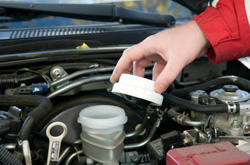Many of the symptoms associated with a brake problem are the result of brake fluid issues (see this link for a list of brake problem symptoms). Fortunately, checking your brake fluid level is a relatively easy process—just follow the steps below and have your car manual handy.
1. Open the hood of your car and find the brake master cylinder.
The cylinder is usually on the driver’s side of the car, toward the back of the engine compartment. Your manual should also include an illustration of your engine compartment that includes the location of the master cylinder.
The brake master cylinder is small and rectangular and has a plastic reservoir and a rubber cap on top, with small metal tubes leading from the cylinder. The cap on top usually reads “use only DOT 3 or 4 brake fluid from a sealed container.”
2. Check the fluid level.
Most reservoirs are usually marked with “minimum” and “maximum” fill lines; the brake fluid level should be between them. Newer cars have a translucent reservoir which allows you to see how high the brake fluid level is without taking off the cap, but you may have to remove the cap on older cars to check the level.
3. If the brake fluid level is low, fill it up.
Before you fill up the master cylinder reservoir, check with your car manual to see what grade of brake fluid your car needs—most cars use Department of Transportation (DOT) 3 or 4. If your reservoir is split in two, fill both halves. Reservoirs should be filled up to the “Maximum” line.
4. If the fluid level is low, check your lines.
A low brake fluid level in the master cylinder indicates that you may have a brake fluid leaking problem which may still persist even after you fill it up. If you have a low fluid level, the next step is to check your brake lines.
Related Links:
Brake Maintenance: 5 Warning Signs
Brake Failure: Emergency Tips
Brake Maintenance: Checking and Replacing Your Brake Lines
Brake Maintenance: Bleeding Your Brakes
Brake Maintenance: Inspecting and Replacing Discs and Brake Pads










